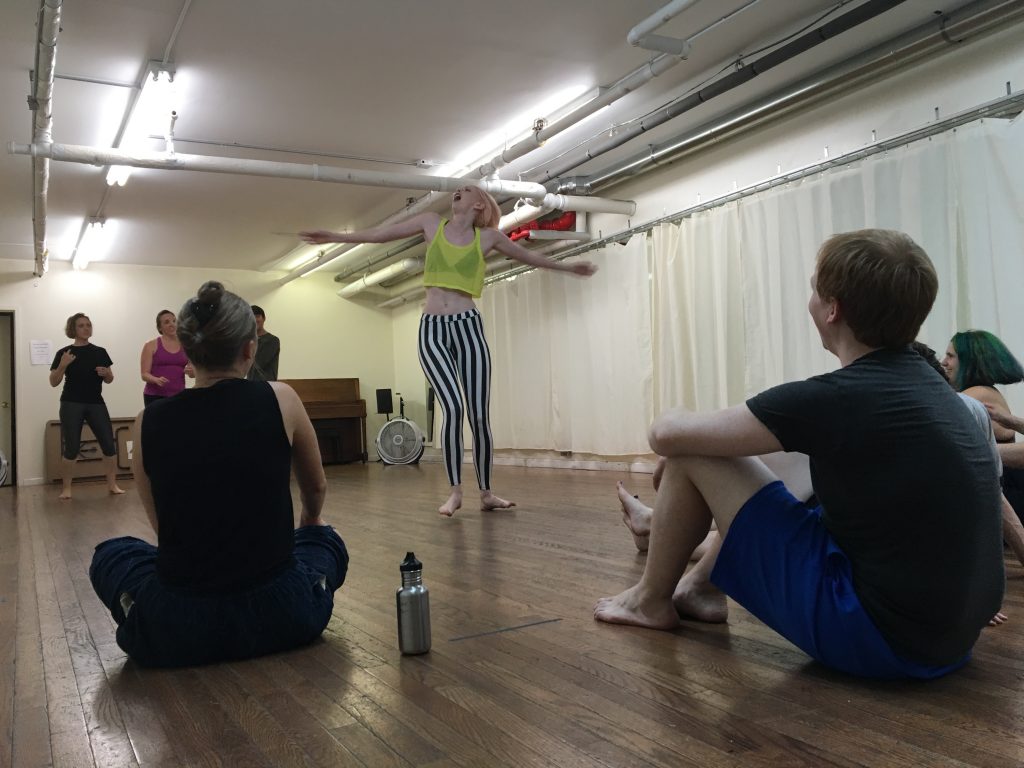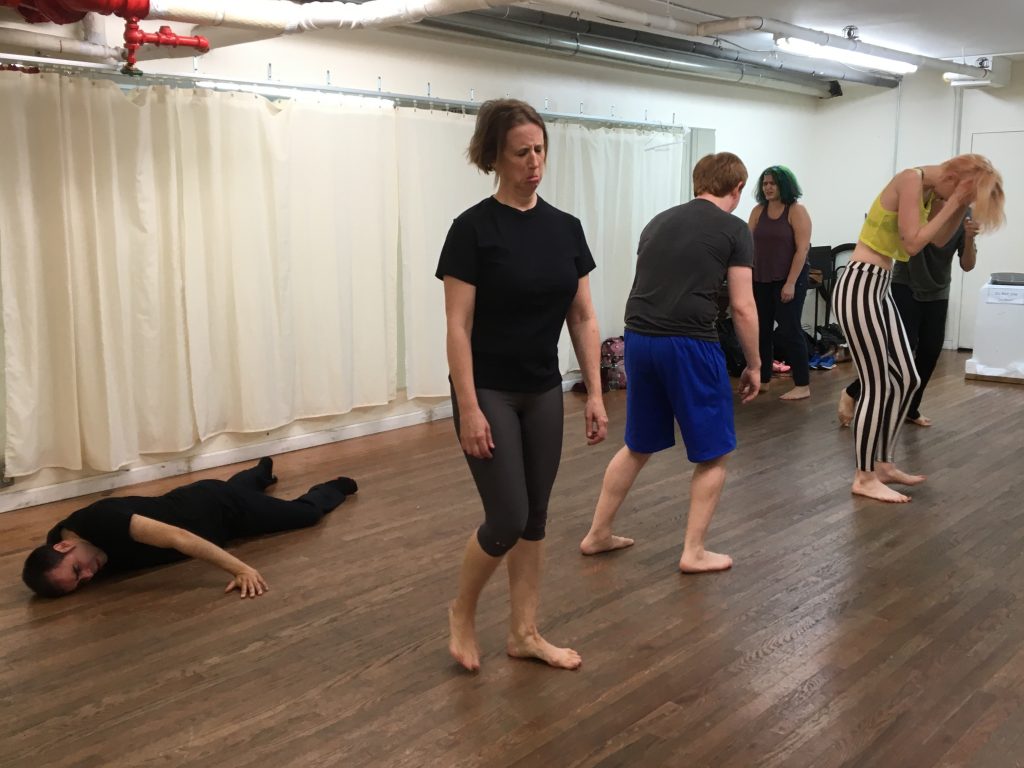
Clown Gym provides performers with an opportunity to get more physical training
“Now, all the tension should be in your butt!” Julia Proctor commanded a group of 8 people standing on all fours in a circle and making funny sounds.
Of all the warm-ups before an exercise, this was probably the most unusual one. But that’s how it is at the Clown Gym’s weekly physical comedy classes in Midtown.
In the lead up to Halloween, reports of people in creepy clown costumes scaring passers-by have been reported in at least 20 states and abroad, some of those cases resulting in arrests. As a reaction to that, some schools and colleges banned clown costumes during Halloween. Even though many of the more serious scary clown sightings involving violence turned out to be hoaxes, there is still a growing concern in the New York clown community.
“Scariness of clowns is something that exists, I think, only in America. In Europe, clowns are respected as artists. Here, it’s been bastardized,” said Proctor, who also went through classical clown training in France.
Professional associations of clowns have already been voicing their concern about the decline in membership numbers in the U.S. for several years. They worry that recent scary clown sightings might further hurt the industry.
The World Clown Association now often receives phone calls from members complaining of “modified performances,” where they are asked to do a show without a clown costume or make-up, the organization reported. Another association, Clowns of America International, reported that many clowns are having their gigs canceled.
Unsettling encounter
While many news stories focus on people scared of the clowns, clowns themselves are actually scared.
Edelis Travieso, president of a local association, NY Clown Alley, has been working as a clown at children’s birthday parties and street fairs for about 10 years. She described an unsettling encounter that happened in Staten Island at the beginning of October.
“I walked out of the gig, still in my costume. As I was walking to my car, I saw a man. He looked at me with this weird reaction. The look in his eyes was a little fearful. It was a narrow, dead-end street, and there was a moment when we both kind of looked at each other, thinking, ‘What are you about?’” she said. “I’ve never felt this way before. For the most part, I always get a smile.”
After the initial fearful reaction, she did get a smile from the man at a dead-end street. But the feeling that something has changed in the way she is perceived remained.
“Now I can’t travel with my clown gear on; I have to take everything off. I used to just travel in my clown costumes, and people would honk and ask for my business card,” she said.
Travieso’s clients have become concerned with her safety, she says. They tell her that she can change into her costume after arriving at their place and want to know when she gets back home safely.
Scary clown is not a clown
Many clowns have been united in a campaign to protect their non-scary image. The World Clown Association has been posting photos of its members on social media to showcase the work that they do. The group’s president, Randy Christensen, even issued a statement to officially distance the work of professional clowns from the scary clown trend. “Please understand, just because someone wears a rubber Halloween mask, that does not make one a clown! We disavow any relationship with these ‘horror characters,’” the statement read.
In a video address posted on YouTube, Christensen accused those behind the hoaxes of trying to distort “a good, clean, wholesome art form.”
Local professional clowns agree. “Whatever the disturbances are being perpetrated are not the responsibility of any actual clowns,” agrees John Townsen, who teaches at the weekly NYC Physical Comedy Lab in Williamsburg. He quoted his own earlier blog post: “Dressing up as an astronaut wouldn’t let me on the space shuttle, but a costume, make-up, and fright wig somehow make me a clown.”
Horrific potential
But some people are in fact scared of clowns, and experts in psychology and art consider this fear stemming from some aspects of a clown as a character.
Noël Carroll, American philosopher and one of the leading experts in aesthetic theory, wrote extensively about the “horrific potential” of a clown in his 1999 essay “Horror and Humor.”
“It is a fantastic being, one possessed of an alternate biology, a biology that can withstand blows to the head by hammers and bricks that would be deadly for any mere human,” he writes. “[Clowns] can be turned into horrific creatures by compounding their conceptually anomalous status with fearsomeness.”
Children are often afraid of clowns, as well as puppets and ventriloquist’s dummies, because “they have not yet mastered the conventions of so-called comic distance,” Carroll observed.
Clowns are “theatrical, ” and it is unsettling to see one outside of the context of performance, speculates Patrick Honey, actor attending the Clown Gym. “Nobody knows what a clown will do,” he added.
Hospitals and schools
Tiffany Riley, who has been working as a clown for 20 years, considers fighting this fear a part of her profession. She was part of the Big Apple Circus and was involved in their clown care unit; then moved to Dallas to start a similar program of her own with her partner.

Tiffany Riley is part of the clown duo Slappy and Monday (Photo: courtesy Tiffany Riley)
In hospitals, she works with children, becoming the only person they can say “no” to in the setting where doctors and parents make all the decisions.
She described one of her techniques: “I ask them, ‘Can I come in?’, and they can say ‘no.’ So I’d start walking away, but my hat would fall off. I’d pick it up, start walking away again, and my hat would fall off again.”
Riley laments that even hospital clowns are treated better abroad than in the U.S. where such programs originated. American hospital clowns are often expected to work as volunteers.
“In 1987, the Big Apple Circus began the clown care unit. From that program, a few people moved to other countries and started similar programs there. Now, in Israel, clowns are in every hospital. In the U.S., even though we started it, we had trouble keeping up,” she said. The Big Apple Circus, a non-profit single-ring circus known for its clowns, recently announced that it would not be pitching its tent this season.

Riley is researching the effect of humor on health (Photo: courtesy Tiffany Riley)
Riley is currently studying for a master’s degree, researching the effects of humor in medicine. She wants to eventually create a program that would allow performers to become certified hospital clowns, thus creating a standard that would simplify the process of hiring clowns for hospitals.
The presence of clowns in public institutions in general is troubling for many in America. Travieso once offered her son’s school to participate in some events, to which the reply was, “No, no, we really can’t. No clowns.”
Clown training
Regardless of Americans’ fear of clowns, training in this art form has been very popular with actors who do not get enough physical training in their theater education, performers note. Clowning has increasingly been added to many children’s theater programs throughout the city and circus camps for children are popular.

Performers portray “despair” as one of the exercises at the Clown Gym
At the Clown Gym, there were some who just wanted to unwind – like bank worker Erin, who was looking for an outlet for stress caused by her job. But the majority of those attending the sessions are performers who want to explore new sides of their artistic personality.
Proctor, their teacher, herself got interested in clowning when she was applying for acting schools. She was told that there is a demand for “impulsive” actors, and, although she didn’t want to become a clown, she fell in love with the art.
“Clowning celebrates failure, and this is not something that is often celebrated in our culture. I was a very driven student when I found clowning. It changed my life, making me more generous, kinder to myself,” Proctor said.
Performers complain that people putting on scary costumes do not understand how much effort and years of training goes into finding your character and establishing yourself as a respected artist. For the professionals clowning is serious, and they hope that the clown scare is dying down.
“Here is our profession, here is life on the line,” Riley said.
